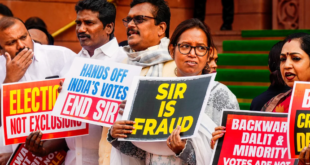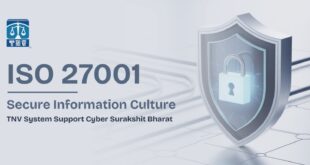 Dr. Utkarsh Sinha
Dr. Utkarsh Sinha
India’s electoral politics appears to be standing at a dangerous crossroads, where the “cleaning” of voter lists and the Special Intensive Revision (SIR) effort are deepening a trust crisis between the ruling powers and the opposition. The recent election results in Bihar must be understood in this backdrop, where along with the NDA’s historic victory, serious questions have also arisen about voting rights and democratic legitimacy.
SIR Controversy: Warnings from Mamata and Akhilesh
Mamata Banerjee has called the Special Intensive Revision (SIR) “voter suppression,” alleging that this practice has become a tool to cut real voters’ names and to make the electoral field one-sided. She warned that if a large number of legitimate voters’ names are removed from the lists, it would shake the legitimacy of both the central government and the Election Commission, and said that the communities labeled as “invaders” are facing a direct attack on their voting rights.
Akhilesh Yadav termed the ongoing SIR in Uttar Pradesh a “conspiracy,” claiming that where the Samajwadi Party and the INDIA alliance are strong, there is a preparation to cut more than 50,000 votes per assembly constituency. He also accused the Election Commission and the government of working together on a plan to eliminate up to 30 million votes, mainly focused on the opposition’s comparatively better-performing seats in 2024.
There is a common thread in the statements of these two leaders—SIR is being seen not as a technical improvement but as a tool of political engineering.

Rahul Gandhi’s Allegations and the “Fake Vote” Narrative
In relation to the 2024 Lok Sabha elections, Rahul Gandhi accused that more than 100,000 “fake voters” were added in seats like Mahadevpura in Karnataka, including duplicate names, illegal addresses, and an unusually large number of voters at the same address. According to him, machine-readable voter data from 10-15 years and CCTV footage can prove that there was organized tampering with the voter list, which he called “100% evidence” of electoral fraud.
The Election Commission dismissed these allegations as “false and baseless,” while the BJP called it a “conspiracy narrative” by a defeated opposition; however, it is also true that recent surveys show a sharp decline in public trust in the Election Commission compared to earlier times.
Thus, on one side is the story of “adding fake votes,” and on the other are allegations of “cutting real votes” through SIR—both together placing the electoral system under a cloud of suspicion.
Is BJP Now Contesting Elections by Reducing Votes?
Fears of large-scale removal of names under the pretext of SIR have strengthened the belief that the ruling side has replaced the old “booth capture” technique with a new “roll capture” technique—meaning removing rival votes from the list even before results come in. Articles and reports mention incidents in Bihar, Karnataka, Haryana, and Aland where either the voter numbers were found to be less than the estimated adult population or real voters were disenfranchised due to wrong photos and addresses.
The BJP and the Election Commission outright reject this entire discourse, calling it a “scientific cleansing of duplicate, deceased, and migrant names.” But when SIR is mainly implemented rapidly in states and areas where the opposition showed gains in recent elections, political suspicion no longer remains an “emotional reaction” but becomes a serious question about the power structure’s strategy.
Under these circumstances, it cannot be concluded outright that BJP is officially working on a strategy to “win elections by reducing votes”; however, the timing, scope, and manner of SIR have certainly broken the trust that the voter list is a neutral, technical document.
Bihar 2025: Results, Statistics, and Political Signals
In the Bihar Assembly elections 2025, NDA caused a kind of political tsunami by winning 202 out of 243 seats, while the Mahagathbandhan was limited to just 35 seats. In vote share too, NDA reached approximately 46-47%, while Mahagathbandhan remained around 38%, showing that the difference in seats was disproportionately higher than the vote percentage.
In this election, BJP emerged as the largest party, while Nitish Kumar took oath as Chief Minister for the tenth time, setting a remarkable example of “long-term political stability”; on the other hand, under Tejashwi Yadav’s leadership, RJD is facing one of its worst situations since 2010.
These results are not just about local leadership or caste equations, but also an expression of the “voter ecosystem” where a combination of state welfare schemes, the “Modi guarantee,” and electoral machinery heavily outweighed the opposition’s fragmented credibility.
SIR’s Shadow in the Context of Bihar
In Bihar, a public interest petition was already filed in the Supreme Court regarding SIR, alleging violation of the universal principle of voting rights and that millions of legitimate voters could be excluded from the list. Reports like those from BBC noted that the draft voter list contained many wrong photos, mismatches, and suspicious entries, increasing voter confusion and exclusion.
Opposition leaders—Mamata Banerjee and Akhilesh Yadav—clearly stated that Bihar’s mandate was affected by SIR and this “game” is now being repeated in other states; on this thesis, they present the “Bihar model” as a warning that if socially conscious societies do not monitor voter lists timely, the possibility of change in power will be eliminated even before the arithmetic.
The Bihar results are also worrying because in many areas, despite feeling an anti-establishment sentiment, the results showed a one-sided picture, intensifying debates about the distance between “popular will” and “declared results.”
Democracy, Voting Rights, and the Way Forward
During the SIR hearing, the Supreme Court acknowledged that the Election Commission has the constitutional right to revise voter lists but also made it clear that local conditions, transparency, and timely, fair procedures cannot be ignored. Court debates suggest that voter lists will now come under strict judicial scrutiny like other constitutional institutions, which is a positive step for democracy—provided the decisions come timely.
On the other hand, reports from civil society, electoral reform groups, and independent media show that tools like SIR are double-edged swords—they can either clean democracy or become instruments of its destruction, depending on how accountable the powers and institutions are.
Today, India’s electoral politics is at such a turning point where the question has become more important than “how many people vote”—it is “how many people are not able to vote.” The results of Bihar 2025 and the rising questions around SIR together warn that if the politics of voter lists is ignored, the next fight will not only be to change the government but to save the right to vote.
 Jubilee Post News & Views
Jubilee Post News & Views





